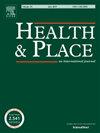Neighborhood intergenerational mobility and population health inequality: Spatial dependency and heterogeneity
IF 3.8
2区 医学
Q1 PUBLIC, ENVIRONMENTAL & OCCUPATIONAL HEALTH
引用次数: 0
Abstract
Health inequity represents a significant social injustice with major policy implications. This study examines the role of neighborhood intergenerational mobility (IM)—defined as the extent to which children within a specific neighborhood can achieve better socioeconomic outcomes than their parents—in shaping population health, addressing widening health inequalities. We propose that neighborhood IM is positively associated with population health, moderated by spatial dependency and heterogeneity. Analyzing over 69,000 census tracts in the contiguous United States using spatially-lagged X models, we find that neighborhood IM is positively associated with health status. The positive relationship weakens in neighborhoods surrounded by neighborhoods with higher levels of IM and strengthens in neighborhoods surrounded by neighborhoods with lower levels of IM. It also weakens in more advantaged environments—characterized by higher socioeconomic indicators, better built environment features, and more favorable natural environment conditions—and strengthens in less advantaged environments with poorer socioeconomic, built, and natural conditions. Our findings underscore the critical role of neighborhood context and heterogeneity in shaping the effects of social determinants on health, suggesting that policymakers should prioritize resources for disadvantaged neighborhoods with lower IM, particularly those surrounded by similarly low-IM areas, to mitigate health disparities more effectively. Our study provides new insights into the role of neighborhood IM in population health and demonstrates the value of geographic approaches for understanding and mitigating health disparities.
求助全文
约1分钟内获得全文
求助全文
来源期刊

Health & Place
PUBLIC, ENVIRONMENTAL & OCCUPATIONAL HEALTH-
CiteScore
7.70
自引率
6.20%
发文量
176
审稿时长
29 days
期刊介绍:
he journal is an interdisciplinary journal dedicated to the study of all aspects of health and health care in which place or location matters.
 求助内容:
求助内容: 应助结果提醒方式:
应助结果提醒方式:


